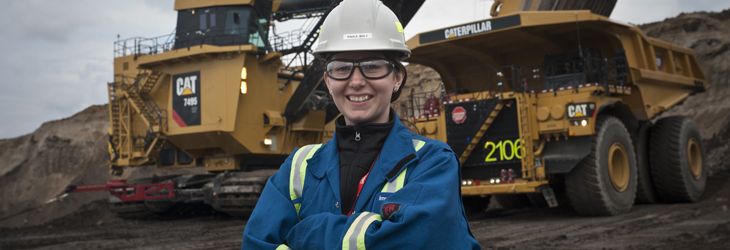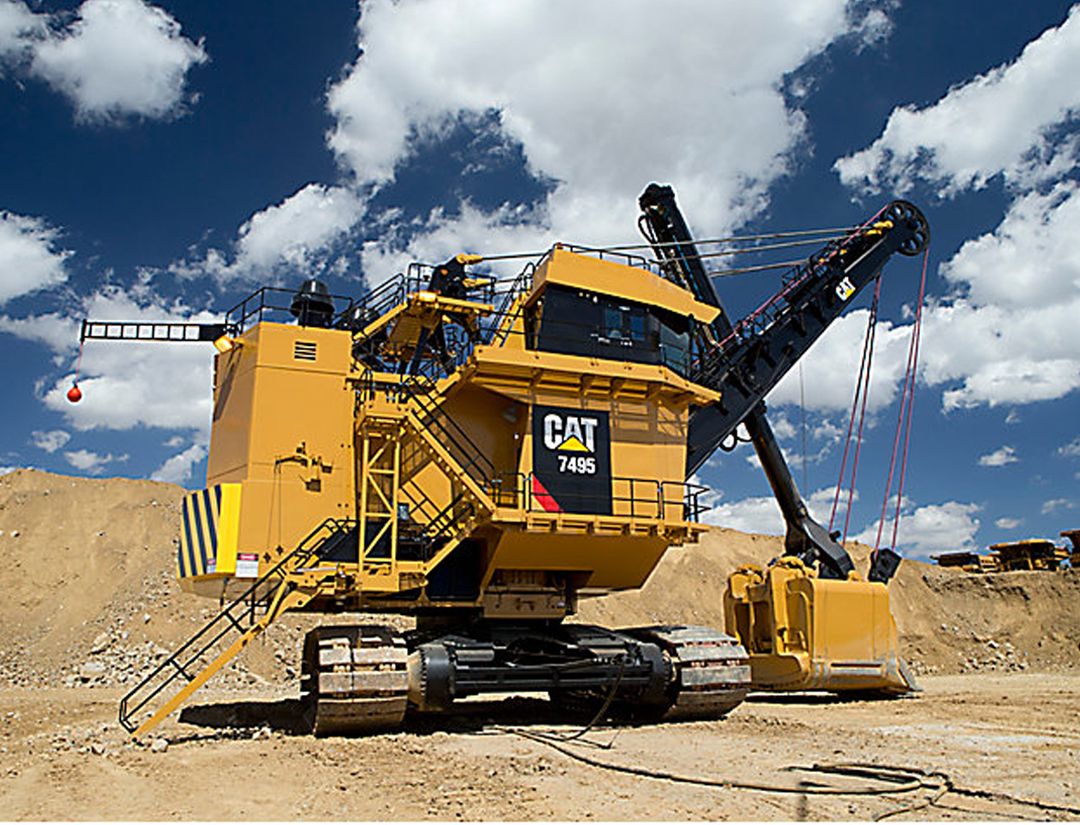

Sign In
Welcome! Sign In to personalize your Cat.com experience
If you already have an existing account with another Cat App, you can use the same account to sign in here
Register Now
One Account. All of Cat.
Your Caterpillar account is the single account you use to log in to select services and applications we offer. Shop for parts and machines online, manage your fleet, go mobile, and more.
Account Information
Site Settings
Security
Mixed Results: How Change Management Impacted Implementation of a New Rope Shovel Technology
The success or failure of a new technology can come down to how your site manages the change. Learn more about how change management can result in better outcomes.
By Caterpillar | Posted March 31, 2022
“People are very open-minded about new things, as long as they're exactly like the old ones.”
So said Charles F. Kettering, an American engineer, businessman and inventor who founded Delco Electronics Corporation and served as head of research at General Motors from 1920 to 1947. With 186 patents to his name, Kettering likely spent the better part of his career introducing new ideas and trying to get people to embrace them.
“Change and uncertainty are unsettling for many,” says Jenny Krasny, Operational Risk Consultant at Caterpillar Inc. and an expert in change management. “Our brain has a bias toward predictability, stability and certainty.”
The good news is change can be managed. “The reality is that the steps for instigating, implementing and managing change are really quite simple,” says Krasny. “But that’s not to be confused with easy.”
Krasny advises Caterpillar customers in a variety of industries on how to implement change in their organizations and operations. Take the global mining industry, for example. Mining companies face constant change — from searching for new ore bodies to adapting to meet local regulations, from keeping employees safe to minimizing impact on the environment. They’re also pursuing profitability, looking for new ways to mine more efficiently and productively.
“The only way to remain viable is to adapt and change,” says Krasny. “With that change also comes the uncertainty. What if the change does not pay off?”
Some changes affect an entire mining operation, like moving from manned equipment to fully autonomous vehicles. Others impact a single operator on a single piece of equipment, such as the introduction of a new machine feature. But no matter the level of the impact, every change must be managed.
“While change management was seen as a ‘nice to have’ only a few years ago — especially for changes that focus on people — today organizations across the globe are recognizing the need for it, and integrating it into their operating philosophies,” says Krasny. “Done well, a people-centered change management process results in greater engagement of the workforce, adoption of the change, commitment to the cause and enhanced performance.”
Implementing Change on Electric Rope Shovels
When a new technology feature was introduced on Cat® 7495 Electric Rope Shovels (ERS) several years ago, the developers knew the positive impact it could have for sites using an ERS as their loading tool. They also knew that some operators would not be accepting of how the new feature impacts their role.
“Typically, the people operating rope shovels are highly skilled and respected operators,” says Bob Riggle, Product Performance Manager in the Cat ERS product group. “Technology can be perceived as a threat to the operator, or an attempt to take their job away. Even those technologies that automate just a piece of the process can come with a negative connotation.”
This particular ERS feature, called Operator Assist – Enhanced Motion Control (EMC), was created to keep operators working within best practice guidelines by eliminating or reducing the occurrence of crowd over-speeds, crowd impacts, hoist stalls, boom jacking, and swinging while digging in the bank.
The feature is compatible with existing Cat 7495 shovels and standard on new models. The software is designed to reduce machine downtime while maintaining productivity, ultimately improving cost per ton.
Depending on the application and digging practices, EMC can deliver:
- A more reliable crowd rope replacement schedule
- Hoist ropes achieving full design life
- Less wear on crowd brakes
- Improved hoist gear case life
“We introduced the feature to our customers about four years ago, presenting it to mine management who saw the benefits and quickly purchased it for their shovels,” recalls Riggle. “Once it was installed, we started getting mixed results. We had calls from some operations that the feature was limiting productivity. At the same time, we had customers reporting good results.”
So why the different outcomes? It came down to how the feature was rolled out to personnel. “The difference was how sites managed the change,” says Riggle.

UNDERSTANDING KEY CHANGE MANAGEMENT PRINCIPLES
While some people create complexity around the topic, Krasny says managing change can be simplified by sticking to some key principles. She recommends the simple framework of the SCARF model, developed in 2008 by David Rock, an author, consultant and leadership coach who advises corporations around the world.
SCARF stands for the five key "domains" that influence our behavior:
- Status – our social standing among our peer group.
- Certainty – about what is expected of us, or what the future holds.
- Autonomy – our sense of control over the change being imposed.
- Relatedness – our perception of who is our friend or foe.
- Fairness – our perception of justice and how it affects us.
The model is based on neuroscience research that implies that these five social domains activate the same threat and reward responses in our brain that we rely on for physical survival.
“The basic premise of the SCARF model is the assumption that the brain makes us behave in certain ways, which are to minimize threats and maximize rewards,” says Krasny. “While the brain takes a threat-and-reward approach to primary needs, such as food and water, the theory argues this also happens with social needs such as recognition, support and acknowledgement. In essence, a positive emotion or reward creates a stimulus making people act, whereas a negative emotion or punishment causes a threat stimulus, which leads to avoidance or resistance.”
So how does this apply to implementing new technology on a mine site? Krasny explains: “It helps us guide the change effort to ensure that our activities and communications about the change compel people to engage, rather than resist.”
EVALUATING SUCCESSES AND FAILURES
While the implementation of the single EMC feature on a rope shovel didn’t require a full change management initiative, the results on individual mine sites clearly show where the basic principles were put into place — and where they weren’t.
On sites where the feature was properly explained, key performance indicators (KPIs) were defined and measured, and operators were trained, the results delivered the touted value. Where operators were not provided detailed information or timely training, there was frustration and negative feedback.
Kerry Klein, a senior product demonstrator and instructor in the Cat ERS organization, worked with multiple sites on the implementation of the EMC feature. He saw the varied results firsthand and believes information and hands-on training worked together to ensure a successful introduction of EMC.
“We started by giving operators insight into how the system worked, explaining the features, and showing them what they would experience,” he recalls.
Explaining the purpose of the EMC goes a long way to ensuring operator acceptance, says Klein. “It’s designed to protect the machine. It’s not a control feature. It’s a protection feature.”
Riggle explains that feature helps address a lack of skilled labor, a critical issue facing mines that have a generation of experienced operators retiring, or greenfield sites with inexperienced labor pools. “We’re not trying to replace operators,” he says. “We want to enhance their abilities. This technology helps new operators quickly get to a high level of sophistication.”
Klein also worked with sites that experienced a less-than-successful introduction of the new feature. In every situation, the problem was a lack of communication and training.
At one location, the system was installed, activated and in operation weeks before classroom instruction was provided by a Caterpillar trainer. Detailed EMC information was provided to the management team, but not accurately passed on to operators.
Vocal operators at another site convinced management that the EMC system was interfering with their operation and productivity. What they didn’t realize was that the software hadn’t even been installed.
“They had seen one of our service engineers working on the machine and a rumor started that he was installing the EMC software,” says Riggle. “He never did install the software. This is just the power of suggestion. They suddenly complained that the shovel was not digging as well. Just the thought of the software became so powerful. The mind is a very powerful tool.”
This example illustrates Krasny’s points regarding SCARF. “The technology threatens status and autonomy — especially for the seasoned, proud operators,” she says. “How the change is implemented threatens certainty and perceived fairness. If I don’t feel informed and involved in the process, I am more likely to reject it.”
While some initial EMC installations were less than successful, the ERS team was committed to helping sites address the issues and working with operators and other employees to make sure the feature delivered the benefits it was intended to provide.
“The good news is that once we sent our operator trainers into the field to sites that were having issues, and once we did the proper training, they started to achieve the same levels of success we saw in other locations,” says Riggle.

REAPING THE REWARDS
On locations where EMC has been properly installed and explained, and operators are well-trained, the technology is delivering results — not only in reducing downtime but also in increased productivity.
Data from a Chilean copper mine indicates significant improvements to shovel operations. In one year, the software detected 779,309 anti-swing in bank events across the mine’s fleet of shovels. Anti-boom jack year-over-year comparison indicated 60% fewer incidents thanks to EMC.
In addition, crowd overspeed was reduced by 80%, from an average of 15 per month to three. Longer-lasting crowd and hoist running ropes reduced costs, increased reliability, and boosted production per set of ropes. Other improvements include hoist stall protection, crowd anti-impact and hoist rope slack prevention. Ultimately in that period, the site saw overall production increase by 25%.
“This site was definitely proactive when it came to change management,” says Riggle. “They worked with their Cat dealer and developed KPIs and metrics to measure success. That was the key to the whole project. They actually got involved with the operators and provided quality messaging — explaining the benefits and how the feature was to be used. They spent time with the operators in the field, and the results were very good.”
The ERS team will leverage these experiences to help in future technology rollouts. They captured the feedback, evaluated before-and-after scenarios, and will use the information to help sites introduce future technologies and features.



